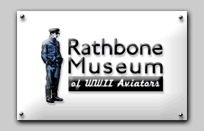 |
|
|
|
|
|
|
 |
 |
 |
 |
 |
 |
 |
|
|
 |
|
|
|
|
Flight Uniform to a Luftwaffe Major on the Western or Mediterranean front
(all items courtesy of Gene Ashton, Collector) |
|
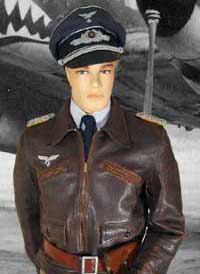 |
|
 |
|
|
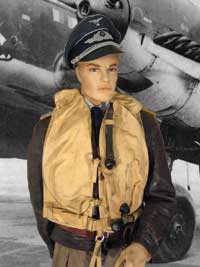 |
|
|
No flight over water would be complete without an inflatable life vest. The major wears and inflatable schwimmweste model 10-30-B2. This was inflated either with a CO2 cartridge built in (near his left hand) or with the manual breathing tube on the chest. The parachute would be put on over the life vest. Pictured behind the Major is an ME-110.
|
|
|
Dressed for the relative warm weather of the western front, this major wears a combination of flight gear, service dress and private purchase items as was the fashion of the Luftwaffe elite. First, he wears an exquisite flight weight officer's cap that was designed to roll up. He then has a private purchase leather jacket with rank and branch of service insignia added. Under that he wears his shirt and tie from his service dress.
(courtesy of Gene Ashton, collector)
|
|
|
The remainder of the Major's outfit is more practical flight gear including summer-weight flight pants (kanalhosen) and flight boots.
|
*Click on any picture to see full size. |
|
|
|
|
|
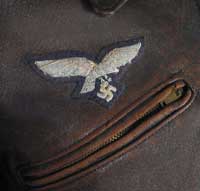 |
|
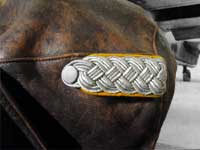 |
|
|
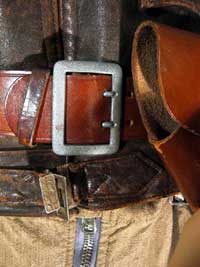 |
|
|
| The rank of major, as the first senior officer rank, is indicated by the heavily woven solid silver braid. More senior ranks were indicated by the addition of metal 'pips' (up to the rank of General, who had different pattern boards.) The slip-on board is attached to the jacket with a sewn on pebble button and a leather loop. |
|
| The Major has had his tailor add a beautifully embroidered eagle to the right chest of his leather jacket. Note, this is a branch of service insignia for the Luftwaffe and not a flight qualification wing. |
|
|
| In preparation for a mission, the Major has strapped on his officer grade belt with his issued sidearm. Pilots tended to carry small automatic pistols to fit in cramped cockpits. Also pictured is the locking built in belt for the jacket. |
|
|
|
|
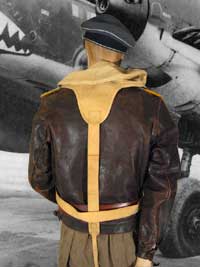 |
|
|
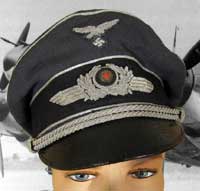 |
|
 |
|
|
| This hat is unique to pilots as it has a thin leather brim designed to be rolled up and put in a pocket. It also produces the desired 'crushed' effect desired by pilots to give the appropriate active duty swagger. The eagle, officer cockade and chi strap are all made of heavy silver bullion |
|
|
The inside of the cap shows the Berlin maker's mark ErEl, the phonetic equivalent of 'RL', which stood for Robert Lubstein, a prolific maker of german military hats, especially for the Luftwaffe. |
|
| The back of the pneumatic 10-30-B2 schwimmweste shows how it is strapped on to ensure a snug fit when the pilot has to bail out. It was designed to keep the pilot's head above water until rescue. The pilot and crew would also have inflatable dinghy kits in case they had to ditch as well. |
|
| *Click on any picture to see full size. |
|
|
|
|
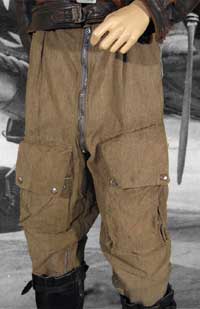 |
|
On the left is a closer view of the summer version of the kanalhosen, or channel pants, which was the nickname given to these flight pants during the many flights to England early in the war. The were part of a two piece suit that featured big pckets for carrying all necessary flight gear. Winter versions were typically blue-grey and were made of leather or fabric and were lined with fur and were later electrically heated. |
|
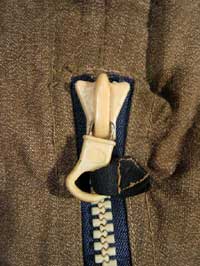 |
|
|
| A close view of the zipper on the right shows the early catalin plastic used as a war economy feature. |
|
|
|
|
|
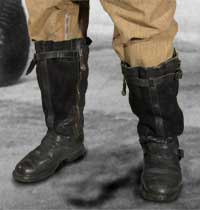 |
|
The boots the Major wears are standard. There were many contractors for these and they came in many varieties even though they were based on the same basic patten. Sometimes black and sometimse brown, they used a combination of boot leather and sheepsking to keep feet warm. Later versions used more sheepskin as leather became scarce. |
|
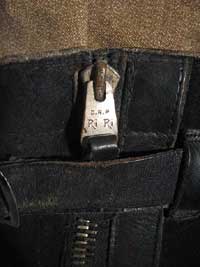 |
|
|
| The metal zipper of the boot made by RiRi, the main german zipper manufacturer. |
|
|
|
|
|
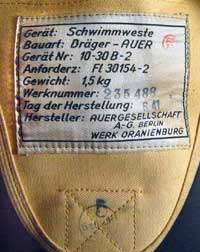 |
|
The tag from the pneumatic life vest, made in May of 1941. |
|
|
|
|
|
|
|
|
| © 2003 Tod Rathbone |
|
|
|
|
|
|
|
|
|
|
|
|
|
|
|
|
|
|
|
|
|
|
|
|
|
|
|
|






















